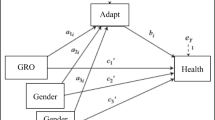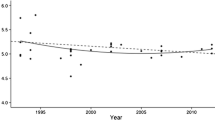Abstract
Bem has hypothesized that “masculinity” (instrumentality) and “femininity” (expressiveness) contribute interactively to adjustment, whereas others have argued that they contribute additively or that only instrumentality is important. To investigate the issue, 92 male and 92 female undergraduates were given the Short Bem Sex-Role Inventory, the Personal Attributes Questionnaire, and a broad range of self-report adjustment measures. Correlational analyses demonstrated that both instrumentality and expressiveness had important correlates with the adjustment indices, and hierarchical multiple regression revealed that they sometimes combined additively, but never interactively. Expressiveness correlated weakly with traditional adjustment indices (global and social self-esteem, and lack of anxiety), but also weakly to moderately with more socially oriented aspects of adjustment, including lower loneliness, lower social distrust, and lower aggression. Instrumentality correlated moderately to highly with self-esteem, lower anxiety, and lower loneliness (although self-esteem mediated the relationships); it also correlated with lack of adjustment in terms of higher Type A behavior and aggression.
Similar content being viewed by others
References
Antill, J. K., & Cunningham, J. D. Self-esteem as a function of masculinity in both sexes. Journal of Consulting and Clinical Psychology, 1979, 47, 783–785.
Bem, S. L. The measurement of psychological androgyny. Journal of Consulting and Clinical Psychology, 1974, 42, 155–162.
Bem, S. L. On the utility of alternative procedures for assessing psychological androgyny. Journal of Consulting and Clinical Psychology, 1977, 45, 196–205.
Bem, S. L. Bem Sex-Role Inventory professional manual. Palo Alto, CA: Consulting Psychologists Press, 1981. (a)
Bem, S. L. Gender schema theory: A cognitive account of sex typing. Psychological Review, 1981, 88, 354–364. (b)
Berzins, J. I., Welling, M. A., & Wetter, R. E. A new measure of psychological androgyny based on the Personality Research Form. Journal of Consulting and Clinical Psychology, 1978, 46, 126–138.
Carmines, E. G., & McIver, J. P. Analyzing models with unobserved variables. In G. W. Bohrnstedt & E. F. Borgatta (Eds.), Social measurement; Current issues. Beverly Hills, CA: Sage, 1981.
DeGregorio, E., & Carver, C. S. Type A behavior pattern, sex role orientation, and psychological adjustment. Journal of Personality and Social Psychology, 1980, 39, 286–293.
Erdwins, C., Small, A., & Gross, R. The relationship of sex role to self-concept. Journal of Clinical Psychology, 1980, 36, 111–115.
Friedman, M. Pathogenesis of coronary artery disease. New York: McGraw-Hill, 1969.
Gaudreau, P. Factor analysis of the Bem Sex-Role Inventory. Journal of Consulting and Clinical Psychology, 1977, 45, 299–302.
Gilbert, L. A. Toward mental health: The benefits of psychological androgyny. Professional Psychology, 1981, 12, 29–38.
Glass, D. C. Behavior patterns, stress, and coronary disease. New York: Wiley, 1977.
Hansson, R. O. Hogan, R., Johnson, J. A., & Schroeder, D. Disentagling Type A behavior: The roles of ambition, insensitivity, and anxiety. Journal of Research in Personality, 1983, 17, 186–197.
Helmriech, R. L., Spence, J. T., & Holahan, C. K. Psychological androgyny and sex role flexibility: A test of two hypotheses. Journal of Personality and Social Psychology, 1979, 37, 1631–1644.
Jackson, D. N. Jackson Personality Inventory manual. Goshen, NY: Research Psychologists Press, 1976.
Jones, W. H., Chernovetz, M. E., & Hansson, R. O. The engima of androgyny: Differential implications for males and females? Journal of Consulting and Clinical Psychology, 1978, 46, 298–313.
Locksley, A., & Colten, M. E. Psychological androgyny: A case of mistaken identity? Journal of Personality and Social Psychology, 1979, 37, 1017–1031.
Lubinski, D., Tellegen, A., & Butcher, J.N. The relationship between androgyny and subjective indicators of emotional well-being. Journal of Personality and Social Psychology, 1981, 40, 722–730.
Lubinski, D., Tellegen, A., & Butcher, J. N., Masculinity, femininity and androgyny viewed and assessed as distinct concepts. Journal of Personality and Social Psychology, 1983, 44, 428–439.
Payne, F. D. Review of the Bem Sex-Role Inventory. In J. V. Mitchell (Ed.), Ninth Mental Measurements Yearbook (Vol. 1, pp. 178–179). Lincoln, Nebraska: Buros Institute of Mental Measurements, 1984.
Payne, F. D., & Futterman, J. R. “Masculinity,” “femininity,” and adjutment in college men. Journal of Research in Personality, 1983, 17, 110–124.
Pedhazur, E. J. Multiple regression in behavior research, 2nd ed. New York: Holt, Rinehart and Winston, 1982.
Pedhazur, E. J., & Tetenbaum, T. J. Bem Sex-Role Inventory: A theoretical and methodological critique. Journal of Personality and Social Psychology, 1979, 37, 996–1016.
Rosenberg, M. Society and the adolescent self-image. Princeton, NJ: Princeton University Press, 1965.
Russell, D., Peplau, L. A., & Cutrona, C. E. The Revised UCLA Loneliness Scale: Concurrent and discriminant validity evidence. Journal of Personality and Social Psychology, 1980, 39, 472–480.
Silvern, L. E., & Ryan, V. L. Self-rated adjustment and sex-typing on the Bem Sex-Role Inventory: Is masculinity the primary predictor of adjustment? Sex Roles, 1979, 5, 739–763.
Smith, K. W., & Sasaki, M. S. Decreasing multicollinearity: A method for models with multiplicative functions: Sociological Methods & Research, 1979, 8, 35–56.
Spence, J. T. Comment on Lubinski, Tellegen, and Butcher's “Masculinity, femininity, and androgyny viewed and assessed as distinct concepts.” Journal of Personality and Social Psychology, 1983, 44, 440–446.
Spence, J. T., & Helmreich, R. L. Masculinity and femininity: Their psychological dimensions, correlates, and antecedents. Austin: University of Texas Press, 1978.
Spence, J. T., & Helmreich, R. L. The many faces of androgyny: A reply to Locksley and Colten. Journal of Personality and Social Psychology, 1979, 37, 1032–1046. (a)
Spence, J. T., & Helmreich, R. L. On assessing “androgyny.” Sex Roles, 1979, 5, 721–738. (b)
Spence, J. T., Helmreich, R. L., & Holahan, C. K. Negative and positive components of psychological masculinity and femininity and their relationship to neurotic and acting out behaviors. Journal of Personality and Social Psychology, 1979, 37, 1673–1682.
Spence, J. T., Helmreich, R. L., & Stapp, J. Ratings of self and peers in sex-role attributes and their relation to self-esteem and conceptions of masculinity and femininity. Journal of Personality and Social Psychology, 1975, 32, 29–39.
Steiger, J. H. Tests for comparing elements of a correlation matrix. Psychological Bulletin, 1980, 87, 245–251.
Taylor, M. C., & Hall, J. A. Psychological androgyny: Theories, methods, and conclusions. Psychological Bulletin, 1982, 92, 347–366.
Tellegen, A., & Lubinski, D. Some methodological comments on labels, traits, interaction, and types in the study of “Femininity” and “Masculinity”: Reply to Spence. Journal of Personality and Social Psychology, 1983, 44, 447–455.
Watson, D., & Friend, R. Measurement of social-evaluation anxiety. Journal of Consulting and Clinical Psychology, 1969, 33, 448–457.
Wheeler, L., Reis, H., & Nezlek, J. Loneliness, social interaction, and sex roles. Journal of Personality and Social Psychology, 1983, 45, 943–953.
Whitley, B. E. Sex role orientation and self-esteem: A critical meta-analytic review. Journal of Personality and Social Psychology, 1983, 44, 765–778.
Wiggins, J. S., & Holzmuller, A. Further evidence on androgyny and interpersonal flexibility. Journal of Research in Personality, 1981, 15, 67–80.
Zeldow, P. B., Clark, D., & Daugherty, S. R. Masculinity, femininity, Type A behavior, and psychosocial adjustment in medical students. Journal of Personality and Social Psychology, 1985, 48, 481–492.
Author information
Authors and Affiliations
Rights and permissions
About this article
Cite this article
Payne, F.D. “Masculinity,” “femininity,” and the complex construct of adjustment. Sex Roles 17, 359–374 (1987). https://doi.org/10.1007/BF00288141
Issue Date:
DOI: https://doi.org/10.1007/BF00288141




